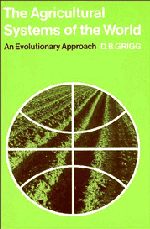3 - The diffusion of crops and livestock
Published online by Cambridge University Press: 10 March 2010
Summary
The distribution of crops and livestock is obviously an important part of any study of agricultural geography; particularly significant are the combinations of crops that characterise different types of agriculture. Explanations of such distributions are usually couched in terms of climatic requirements, the suitability of soil, variations of demand and the availability of labour. But in the longer perspective there is a different problem. Most crops are, within their climatic limits, very widely grown. Wheat, for example, is found near the Arctic Circle and in upland areas near the Equator, whilst it is grown in the east of the Old World in Japan and in Ireland in the west. The great range of modern crops has led one authority to write ‘at the present time almost everything is almost everywhere’.
In contrast, the wild varieties from which crops have been bred were confined to a very small part of the earth's surface – about 10 per cent according to Vavilov – and most of the earth has produced no significant plants for man (Fig. 5). Most of the crops now grown had been domesticated by 2000 B.C. or before, but many were confined until quite recently to the region in which they were first domesticated. (See Appendix.) Until the fifteenth century, the diffusion of crops was slow – and there had been no exchange of plants between the Old and the New World. But by the late seventeenth century botanical gardens were established with the express intention of speeding the exdhange of crop and decorative plants.
- Type
- Chapter
- Information
- The Agricultural Systems of the WorldAn Evolutionary Approach, pp. 24 - 44Publisher: Cambridge University PressPrint publication year: 1974



